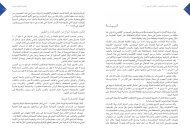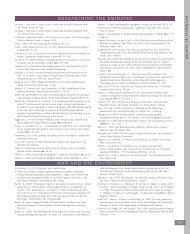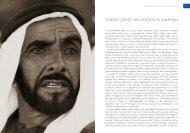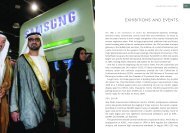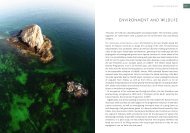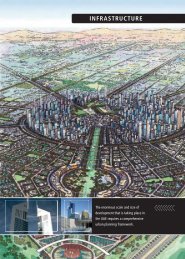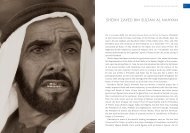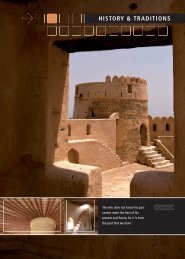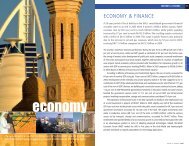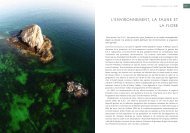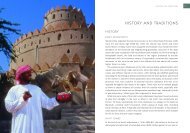You also want an ePaper? Increase the reach of your titles
YUMPU automatically turns print PDFs into web optimized ePapers that Google loves.
136UNITED ARAB EMIRATES YEARBOOK 2006<strong>ECONOMIC</strong> <strong>DEVELOPMENT</strong>137known structures and exploration purposes to find new reserves and a 3D surveyof the Bab field to improve reservoir characterisation and help optimise developmentschemes. The main focus on future exploration/ appraisal is in the south-eastportion of ADCO’s concession and undeveloped reservoirs overlying/ underlying orproximate to reservoirs currently on-stream.ADCO is currently undertaking expansion projects to add some 400,000 b/dto its sustainable crude oil production capacity. These include expansion of theonshore Bab field (adding 100,000 b/d of facilities) to achieve a sustainable capacityof 350,000 b/d by early 2005 and full field development of four north-easternfields (Al Dabb’iya, Jarn Yaphour, Rumaitha, Shanayel) to increase their capacityfrom 10,000 b/d to 110,000 b/d. The work is scheduled for completion in the firstquarter of 2006 and will provide sustainable capacity of 70,000 b/d at the AlDabb’iya and Jarn Yaphour fields and 40,000 b/d at the Rumaitha/Shanayel fields.Work planned to be completed in February 2006 at the Bu Hasa field, to replaceageing production facilities and enhance pressure maintenance schemes, involvesgas and water injection facilities with a capacity of 150 million standard cubicfeet/day of gas and 120,000 barrels water per day. It is expanding capacity of theBu Hasa field by 180,000 b/d, from 550,000 b/d to 730,000 b/d.Work on Huwaila, located 30 kilometres south of the Bu Hasa field, began inAugust 2003. The field’s Shuaiba Unit H reservoir enters production in 2006 ata designed rate of 10,000 b/d. Additional wells are due to be drilled in 2007.This is an innovative development using multiphase pumps to deliver the fluids(oil/water and gas) to Bu Hasa where they are separated and processed. Thesecond phase of development of the Sahil field will also add 20,000 b/d capacityby 2008. Development work at the Asab field, aimed at boosting production by30,000 b/d, has also been progressing. Water injection facilities at the field havebeen renovated by Veco Engineering, which also holds a contract for maintenanceof 1311 wells at various fields operated by ADCO.The recently completed work undertaken to increase capacity of the Bab fieldfrom 250,000 b/d to 350,000 b/d involved installation of two new processingtrains, two-phase and three-phase gas/oil separator plants, a new central degassingstation and associated pipelines. Meanwhile, gas injection at the field was increasedby 120,000 cf/d, from 280 million cf/d to 400 million cf/d.Abu Dhabi already applies the most up-to-date production and drilling technologyat its oilfields. Both water and gas injection are in wide use at older fields tosustain reservoir pressure and maintain flow rates. Moreover, operators are drillinga growing number of horizontal wells to improve well productivity and boostrecovery rates. Many of these, particularly in the Rumaitha and Al Dabb’iya fields,are drilled as clusters from a relatively small area and the wells deviated to theirtarget zones to minimise the surface footprint. This reduces field congestion andcontributes to ADNOC Group’s environmental protection programme.Abu Dhabi’s operating companies have acquired considerable expertise indirectional drilling methods and utilise short, medium and long radius drillingtechniques in conjunction with both oriented and conventional coring. The longesthorizontal hole drilled in Abu Dhabi was an 1830-metre section drilled by ADCO.Whilst the prime responsibility for gas field development and production inAbu Dhabi is that of GASCO and ADGAS (see section on gas below), ADCO also hassome involvement in development of gas fields and undertakes production andprocessing of gas on behalf of ADNOC. Gas is presently recovered from the Asaband Bab fields. Bab presently yields around 3 billion cf/d of gas, whilst Asabproduces 826 million cf/d, bringing onshore gas production managed by ADCOto around 4 billion cf/d. Meanwhile, ADCO is tackling increasing corrosion atits onshore fields. In February 2004 it awarded a US$50 million contract to aconsortium specialising in this area. They are tasked with providing cathodicprotection for approximately 1500 wells and are scheduled to complete the workin 2007/08.ADMA-OPCOThe Abu Dhabi Marine Operating Company (ADMA-OPCO) is the second biggestoil producer in the <strong>UAE</strong> after ADCO. The two companies account for more than80 per cent of Abu Dhabi’s total crude oil production. ADMA-OPCO is responsiblefor development and operation of the Umm Shaif and Lower Zakum offshore fields.With an area of 360 square kilometres, Umm Shaif has 268 producing wells andis located about 140 kilometres north-west of Abu Dhabi City. The Lower Zakumfield, covering 1270 square kilometres, has 321 wells tapping into five productivezones. It currently produces 220,000 b/d, making it one of the largest offshoreoil fields in the world. Water injection is used to maintain pressure in the reservoir.Lower Zakum and Umm Shaif have rated capacities of 320,000 b/d and280,000 b/d respectively, but their sustainable capacities are considered to beapproximately 240,000 b/d and 220,000 b/d respectively. The company currentlyproduces around 420,000 b/d of oil that is obtained via multiple wells tappinginto the productive zones. Current plans are to raise their sustainable capacitiesto levels that were previously regarded as their maximum levels. This is beingachieved through drilling of new production and injection wells and construction ofprocessing and compression facilities to extract gas from the field’s Khuff reservoirand re-inject it into the Arab C and D oil reservoirs. Scheduled for completion in2006, the project will double the gas injection capacity of the Umm Shaif field.ADMA-OPCO commissioned a 1500-square-kilometre seismic survey of theseabed in the Zakum field. The aim was to boost productivity of both parts of theZakum structure through enhanced reservoir definition. In addition, the surveycould provide the baseline for a future time-lapse 3D reservoir monitoringprogramme. Current development of the Zakum field is utilising this data.



